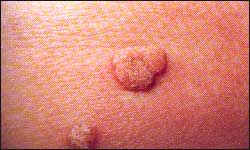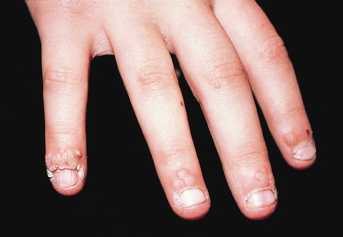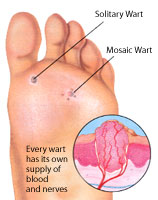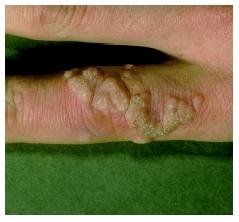



WARTS
 |
 |
 |
 |
Introduction
What Are Warts?
Warts are tiny skin infections caused by viruses of the human papilloma virus (HPV) family. Although children get warts most often, teens and adults can get them, too. Sometimes warts are sexually transmitted and appear in the genital area, but most warts appear on a person's fingers, hands, and feet.
Some people appear to be more susceptible to warts than others. In fact, some people never get them. Doctors aren't really sure why this is and think it may be that some people's immune systems make them less likely to get the virus that causes warts.
The viruses that cause warts are passed from person to person by close physical contact. Having a tiny scratch or cut can make a person more vulnerable to getting warts.
What Are the Signs and Symptoms?
If you find a small, hard bump on your skin that has a rough surface similar to that of a cauliflower, it's probably a wart. Warts can look pink, white, or brown, and can contain tiny spots inside that look like black specks. Warts can affect any part of the skin, but are most often found on the extremities - fingers, hands, and feet.
Warts are usually painless, except for those on the soles of the feet. These are called plantar warts, and if you have one it can feel like walking on a small pebble. Warts on the palms of the hands or soles of the feet may appear level rather than raised.
Sometimes warts can itch or bleed. They may also become infected with bacteria (from scratching or picking) and become red, hot, or tender.
Can I Prevent Warts?
There is no way to prevent warts, but it's always a good idea to wash your skin regularly and well. If you cut or scratch your skin, be sure to use soap and water because open wounds are more susceptible to warts and other infections.
It's also a good idea to wear waterproof sandals or flip-flops in public showers, locker rooms, and around public pools (this can help protect against other infections, like athlete’s foot, too). If you do have warts, don't rub, scratch, or pick at them or you may spread the virus to another part of your body or cause the wart to become infected.
How Long Before Symptoms Appear?
The length of time between when a person's exposed to the HPV virus and a wart appears varies, but warts can grow very slowly and may take many months to develop.
How Long Do Warts Last?
Warts are different in different people. In time, many warts disappear on their own.
With treatment, warts can usually be removed within a few weeks, but they may come back if the virus causing them stays in the skin.
Disclaimer: This information is not intended be a substitute for professional medical advice. It is provided for educational purposes only. You assume full responsibility for how you choose to use this information.